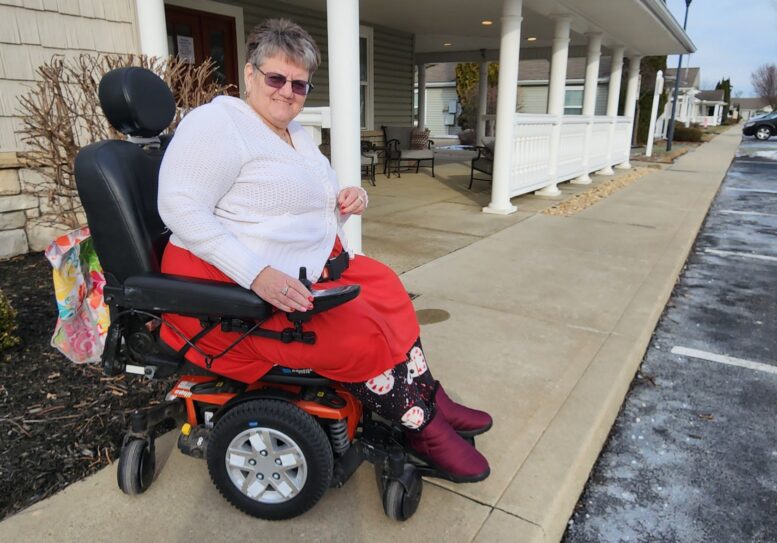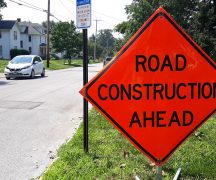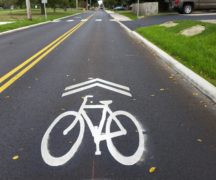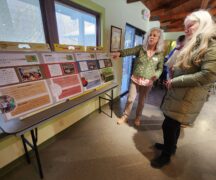By JAN McLAUGHLIN
BG Independent News
Debbie Thompson is an accidental advocate. Out of necessity, she has become a champion for people who rely on sidewalks and the city transit service to navigate Bowling Green.
With her well appointed — and decoratively adorned — motorized chair, Thompson frequents places she formerly traveled to by car.
Thompson, who was diagnosed with multiple sclerosis 26 years ago, gave up her car five years ago. So she uses her power chair, which on good pavement can reach speeds up to 6 mph, and the city transit service to get her where she wants to go. But both have their limits – due poor sidewalk conditions and limited transit hours.
Sidewalks
While MS has greatly affected Thompson’s life, she wants to continue going to the places that bring her joy. From her home on Chauncey Lane, she uses her power chair to get to her nail appointments at Greenwood Centre on the far east edge of the city, Sundae Station and the Wood County Fair on the far west side, Kroger on the far north, and Walmart on the far southern edge.
As long as it’s not raining or snowing, Thompson also motors her chair to BGSU Ice Arena for hockey games, Bowling Green City Council meetings, Belleville Meat Market, and the downtown farmers market.
But even if the weather is fair, Thompson frequently encounters a lot of hazards along her routes.
She finds her travels interrupted by sidewalks that are broken from age and buckled by tree roots – and some that just end in the middle of block, forcing her onto the roadway. She has posted a slow moving vehicle triangle and light on the back of her wheelchair, and an orange BGSU flag to help motorists see her.
Even with those precautions, Thompson has had more “close calls” than she cares to remember. A repeated problem spot has been the intersection of North Main Street and Poe Road, where motorists often stop their vehicles in the crosswalks or don’t wait for her to get across the four lanes.
Traveling to Meijer for groceries can be especially tricky, since the sidewalk ends at Dunbridge Road and East Wooster Street.
“Semis will pass me, but I don’t have a choice,” she said.
Getting to Wood County Hospital can also be risky, since the sidewalk on the north side of West Wooster Street, between Haskins Road and the hospital is not separated from the roadway.
“I could reach out and touch the cars,” she said.
Thompson recounts close calls when cars turned in front of her as she used the crosswalk near BG Manor, and when traveling home from a City Council meeting last year, when she was almost clipped by a car turning left in the crosswalk.
“Until you’re in this seat, you don’t know,” Thompson said.
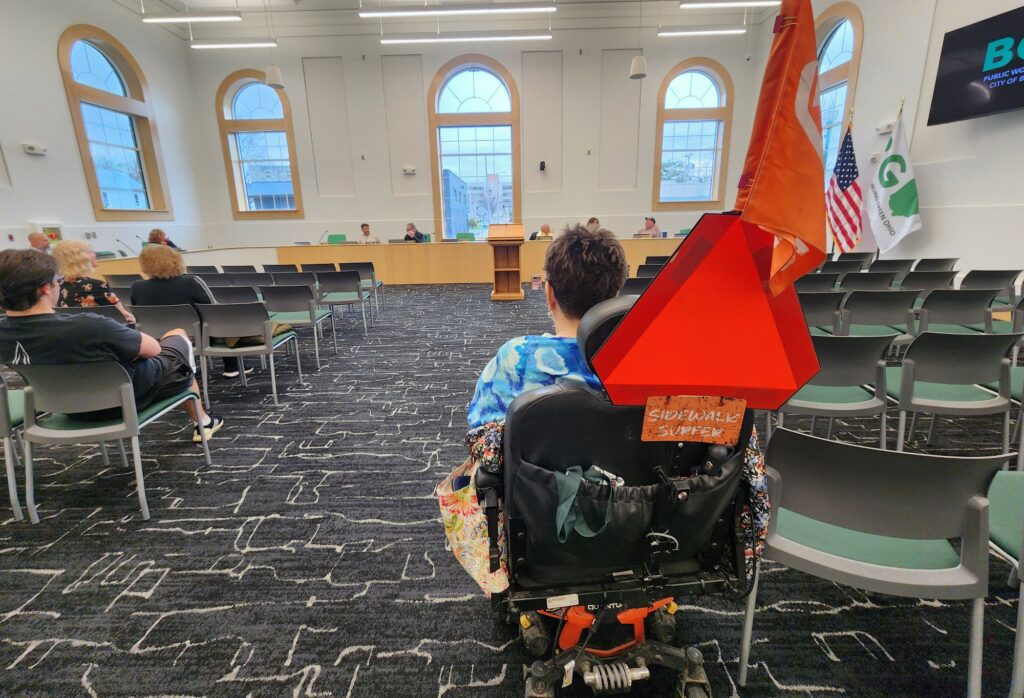
Advocacy
Thompson has learned to not be timid in her advocacy for herself and for others who use wheelchairs or need transportation around Bowling Green.
She does not hesitate to report big breaks in sidewalks to city and university officials, and to send along photos as visual proof. She makes phone calls, and she fills out online forms describing the hazards.
“I need to educate them,” she said. “I need to advocate for myself.”
Thompson has also been known to call a local landlord when their vans cut her off in crosswalks.
She has reported overgrown mulberry bushes, invading sidewalk space.
“There’s another one I need to follow up on,” she was reminded as she talked about impediments to people using wheelchairs.
Perhaps her biggest success was getting a good pathway along East Wooster Street on the overpass above Interstate 75. She reported to the city that the blacktop kept settling, leaving gaps in the pavement. To remedy the situation, the city installed a concrete walkway.
“I’ve never been involved in anything political in my life,” Thompson said. But she appears quite comfortable in the role she has adopted out of necessity.
Recently she joined the transportation and mobility committee of the Save Our Neighborhood Group’s Call to Action effort, and she is hoping to get a seat on the city’s sidewalk committee when a spot opens.
Bowling Green Public Works Director Mick Murray said he does not view Thompson’s persistence as a thorn in his side.
“I appreciate when she notifies us,” he said.
The city requires sidewalks to be installed when property is developed. But it hasn’t always been that way. So while the city has approximately 108 miles of sidewalks, it has 76.5 miles with no paved walkways, according to Murray.
The Westgate and Belleville subdivisions on the west side of Bowling Green were constructed prior to the sidewalk requirement.
Efforts are being made to fill in gaps linking sidewalks that just end in the middle of blocks. And the city is working on three shared use paths, one on South Main Street, one between the high school and community center, and one between Crim Elementary and Carter Park.
When the city undertakes roadway projects, sidewalks and ADA ramps are updated. A 50/50 program sharing the cost between the city and landowners continues to be offered to make it easier for homeowners to replace sidewalks – which average about $4,500 per property, Murray said.
Sometimes problems reported by Thompson require fast action — such as the gaps in the asphalt leading up to the bridge deck on the East Wooster Street overpass.
“That was an immediate priority,” Murray said.
The city just underwent a sidewalk scanning study, which will help officials prioritize which walkways are repaired before others.
“Before it was very subjective,” Murray said.
The city’s sidewalk commission relies on input from people who depend on sidewalks to get around the community.
“It’s really helpful to get their perspective,” said Martha Woelke, the city’s community development administrator. “They actually live it.”
Transit
Thompson and many others in Bowling Green rely on the city transit system to get them to local destinations. The service is affordable – $4 to go anywhere in town and $2 for those with transit cards, Thompson said.
But the hours are too limited for Thompson.
The transit hours are Monday through Friday, from 6 a.m. to 8 p.m., and Saturday from 10 a.m. to 4 p.m. The service has no hours on Sundays or holidays.
“What if I wanted to go to dinner? I can’t,” Thompson said of the limited weekend hours.
To see her grandson play hockey, Thompson has to travel by her power chair to the BGSU ice arena, because games aren’t over until well past the transit’s operating hours. That means she navigates in the dark to get from the arena to home.
“I shouldn’t have to do that,” she said.
There is no Uber service in BG since the demand is not great enough, she said. And the other privately owned transportation services operated in the city are not handicapped accessible, she added.
Ideally, the city would be able to offer more transit hours on the weekends, but the demand just doesn’t justify it, Woelke said.
The weekend use ranges from 20 to 41 riders. The weekday riders average 90 a day. All the vehicles are wheelchair accessible, with one equipped to take larger chairs. The service racked up 120,000 miles last year, Woelke said.
“Our money from ODOT has gone down every year since I’ve been here,” said Woelke, who has been in that role for four years.
The transit service is expensive to operate, costing about $650,000 a year, with less than half coming from the federal government. The city owns the vehicles, and works with Black & White taxi service to operate. The cost of a new heavy duty van was estimated at $72,000.
The fares cover about 10% of the operating costs, Woelke said.

